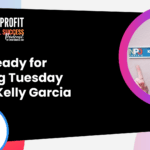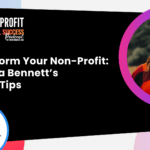Video recording
Audio recording
In this episode, we’re happy to have Amy Laski! She is a passionate and award-winning business leader who thrives on identifying and acting on the opportunities in every challenge. Armed with her business education and over 20 years of integrated communications experience as a client and a consultant, Amy flexed her entrepreneurial muscle by founding a virtual PR agency, Felicity.
The Felicity “Brains not Bricks™” model breaks the traditional agency mould, delivering a completely client-centric experience based on outputs (not billable hours).
We brought her on the show to thoroughly discuss why a nonprofit needs PR to reach out to a larger audience, build successful relationships and alliances with supporters, and promote the causes they care about.
Mentioned Resources
Episode Transcription
David Pisarek: Welcome to the Nonprofit Digital Success Podcast. I’m your host, David, and in this episode, we’re going to be talking about all things PR with Amy Laski. Amy, thank you so much for being here.
Amy Laski: Thank you for having me.
David Pisarek: Amy is a passionate and award-winning business leader who thrives on identifying and acting on the opportunities in every challenge. Armed with her business education over 20 years of integrated communications, and experience as a client and as a consultant, Amy flexed her entrepreneurial muscle by founding a virtual PR agency called Felicity.
The Felicity “Brains not Bricks” model breaks the traditional agency model, delivering a completely client-centric experience based on output (not billable hours).
In her spare time, Amy is super busy, she’s working out, travelling with her family, and leading the girls’ tween hockey league that she started volunteering on the board of the summer camp. And she’s also trying to learn guitar. Thank you for finding some time, a little bit of time, to join the podcast. How’s your day going?
Amy Laski: So far, so good. No guitar playing, unfortunately, but PR.
David Pisarek: We’ll have you on with the guitar. You can play a little song or something.
Amy Laski: Yeah.
David Pisarek: Let’s talk about PR. And I guess the best place to start is, what is PR?
Amy Laski: Sure, yeah. We get that a lot because a lot of people think PR is getting media coverage, but it’s so much more than that.
PR is basically understanding who your audiences are as an organization or as an individual, and then building relationships with those audiences.
And those can be either direct relationships between your organization and those audiences, or they can be indirect. So, you know, who does the audience trust already, and how can we develop relationships with those trusted sources of our audiences?
David Pisarek: Awesome. And you’ve been doing this for 20 years. What is it that you love about it?
Amy Laski: What I love about it is that you have to look from the perspective, you have to look from the outside perspective yourself. I feel like having worked in a corporation (a big corporation), marketers especially, can have a tendency to navel gaze. “Here’s what I would think as a consumer. Here’s what I would think if I was a doctor or a donor”.
I think for PR, you first and foremost have to start with what’s important to the audience and what’s going on in their world so that I, as a brand champion, can make myself relevant to their lives and make myself useful. I think it’s really slipping taking that perspective. A lot of times it requires creativity and the relationship-building aspect. It’s really about understanding how you can kind of make a WIN-WIN-WIN in any given situation.
David Pisarek: 100%. Being able to, as a nonprofit and charity, create a relationship with somebody, create that strong bond, will make them care about what it is that you do.
I often talk about trust factors and building upon those will help you get brand ambassadors, it will help you get volunteers, it will help you get people that care about your organization that might be willing to hit share on an article or news release, or something like that. And ultimately, we’ll help you get donations.
Amy Laski: That’s for sure. An easy analogy I use in helping to explain what PR is, versus advertising… Advertising: you as the brand are buying your way into the lives of your audiences. It’s like a movie. You can have a movie poster or an ad for a movie saying this is the best movie of all time, “You have to see this movie”, but if your favourite movie reviewer or blogger or Instagrammer says, “Hey, this is an awesome movie, you should go see it”, it has that added credibility.
You’ve already trusted that movie reviewer or that podcaster or whatever, and you’re way more likely, as that audience, to act upon their recommendation because you’ve already got that trusted relationship. Two thumbs up really need something much more coming from somebody you trust versus from the brand itself.
David Pisarek: 100%. And I think that’s why some of these platforms like Rotten Tomatoes or whatever, where you can go, and you can crowdsource and go, “Okay, yeah, you know what, a lot of people really like this, maybe it’s something that I should look at” and relying on some metrics like that can certainly help, for sure.
So in terms of PR, a lot of people think about content. What about content? What does that mean to you?
Amy Laski: Content, I think, is really, again, understanding what’s important and what is a voice that you can sell as a brand in your audience’s life and how can you serve their need for learning more about that.
You, yourself as an organization, can put out content. It can be anything from a newsletter to a blog to your website, to social media feeds. You as a brand can publish that, but then you can also curate content. You can as an organization curate the best information about a given topic.
If you’re working for a health brand, then that’s a deep state. You could curate information and be valuable and add value to your audience’s lives in that way, so they don’t have to themselves do all the legwork. You’re going to do the legwork for them, you can collaborate on content.
Identifying who or what other organization has a mutual interest in reaching that audience, or better yet, as a nonprofit. Is there an organization that already is a part of my audience’s life and working with them to create content, bringing both your strengths to the table? That’s just an example of the types of content and how it might work.
David Pisarek: Love that idea in terms of collating and going out and finding other people’s content that you can push out to your audience and go, the first half of 2022, “These are some of the breakthroughs that happen with cancer research globally”.
These are things that we should be talking about and thinking about or having conversations around, and making sure that you’re building authority by talking about things that aren’t necessarily only your own.
Amy Laski: I think the ideal mix has a little bit of everything. And so, yeah, we’ve been successful with our newsletters on well-being marketing. So there’s no one place, to my knowledge anyway, other than us that curates different content about marketing in the well-being space.
Certainly, there’s a lot of marketing going on regarding well-being issues, but nobody looking at it from a marketing standpoint and putting those pieces together. I think that we add value in that way. It’s very much curated content, “Here’s what this brand is doing and how they’ve chosen to relate their brand to well-being and provide our slant on it”. That’s the content we’re putting out. It’s not the original piece of work.
People are looking to simplify their lives, and if you can do that as an organization and not reinvent the wheel, but just kind of make the wheel a bit better, then that’s really useful for sure.
David Pisarek: You mentioned well-being marketing. What is well-being marketing?
Amy Laski: That’s kind of a catch-all umbrella for brands and how they impact people’s well-being.
I think any brand knows that consumer research showed that people expect any brand, even an insurance or financial services brand, to address well-being in some way. Even though that may not be kind of their core line of business, it’s got to be part of their business in order to pass muster with consumers.
That’s well-being marketing: how are you, as a brand, going to embrace well-being in some way to meet those demands of what people want today, especially in light of COVID? Well-being is top of mind.
David Pisarek: To that point, COVID brought around a lot of things like the way that we think about work, for example, working from home instead of in an office. I know you have a virtual agency. I have a virtual agency where we’re maybe a little bit of outliers pre-COVID in terms of that. Well-being is a big part of it.
There’s the great resignation piece that’s getting lots of media play about people leaving their jobs because they’d rather be working from home. They feel that they can contribute more instead of going into an office, and they save cost on travel and that, but also their time.
Making sure that you’re staying on top of the well-being as a business or as a nonprofit or charity, will really resonate with the audience that you really need to think about connecting with to help cultivate into ultimately being a donor
Amy Laski: 100%. I think, again, it comes back down to whether it’s employees or donors, or even people who are nonprofit benefits, what do they want, what’s important to them? And then acting in that way.
I mean, many people, when COVID first hit, were asking me, “Oh, you’ve run a virtual company for so long. What are some of the things you know? Can you share your secrets and your tips?”. I wish there was a silver bullet, but there really isn’t.
There’s that unique recipe that works for each company based on what’s important to their organization and what’s important to their organization’s audiences.
And really, I think it comes down to listening to what your people want and then addressing it.
David Pisarek: At that point, you need to talk to them, right? You need to find out what is it that they want. You can think about, you can sit and have all kinds of strategy meetings at the Wazoo trying to go, “Okay, this is what we believe our audience cares”, but until you actually go and validate that information, go, “You know what? This actually rings true”, or “Holy cow, I can’t believe that we thought this. This is like the exact opposite of it”.
I think there’s a lot that can come from stakeholder engagement meetings and involving the community that believes in your cause and is with you to that end.
Amy Laski: Yeah, we actually call that “in reach”, it was a term we coined because I think traditionally marketers and communicators and fundraisers even think of, “We have to do outreach, so we have to think of what message we want to get out, and then we have to go out and get that message to them”.
And I think that, if you flip it over, I think it would apply very well in a nonprofit setting when you’re trying to raise funds and raise support.
Otherwise, I think if you start off, you can bring some key stakeholders into those planning meetings and have them be a part of setting out what you’re going to do.
And I prefer the term “engagement” rather than “outreach” because it really speaks to that kind of two-way street. It shouldn’t be developing the message in the boardroom and then going out with it when we’re ready to launch. It should be an iterative process and involve key stakeholders as early in the process as possible in that form of “in reach”. I think will make you all that much more successful.
David Pisarek: Having said that, you do need somebody to steer the ship. You need somebody to have the will and the guts to stand up and go, “You know what? We need to do this in reach. We need to do engagement instead of just pushing that, and it needs to come from really the top down”. It needs to be a collaborative approach that everybody buys into.
Amy Laski: Yeah. The most successful processes that we have run are when that talk is part of the meeting because it can be very eye-opening. In a more traditional sense, people are scared of opening the test labs, as it can be disarming when you’re used to planning everything.
Listening, I think, is one of the most compelling forms of communication and that’s really where that comes to plan. Everybody’s eyes are open, and the ultimate product is way more successful as a result.
David Pisarek: 100%. When we’re talking about marketing and PR and content, how do those all play? And I hate to use the word synergy because it’s way overused, but how do they all kind of culminate in an awesome experience?
Amy Laski: I think there’s no solid line between all the pieces of the marketing mix anymore. It’s very hard to distinguish where one piece like marketing begins and PR ends, or whatever. It doesn’t work that way from my experience anymore because a big part of marketing is social media or digital.
A big part of digital is not just putting stuff out there, it’s getting stuff in, getting people to come to you.
I think it’s all interconnected. I think that everybody has to work hand-in-hand and just figure out who’s going to do what behind the scenes within your organization, and I think that everything has to work together because there is no solid line between us and them anymore. Even with internal to the organization and external the organization, like we just talked about.
David Pisarek: I think that’s very true. And when we talk about that, we think about being partners and collaborative and working together, and there are other types of partnerships as well.
There are strategic partnerships and alliances that you can have. How did those types of partnerships play a role in PR and marketing and content?
Amy Laski: I think from a PR perspective… I’ve worked on many partnerships in my career, and ultimately you’re looking for the whole to be greater than the sum of its parts, not just putting two pieces of a puzzle together when you put those two plus two equals five.
What do you bring to the table that will complement the other party’s abilities and strengths?
One of the partnerships we engaged in when I was working at Coke many years ago was in the lead-up to the Olympics. Coke was obviously a global sponsor of the Olympics, very synonymous with it. We had access to a bunch of spots on the torch relay, but we faced a lot of criticism.
And that was actually my job, to figure out what to do with all the criticism Coke was facing with regard to the obesity debate. And what does Coke know? Coke knows how to market and how to engage and excite young people, especially, and had also a sedentary crisis in Canada, kids and youth were not active. In the lead-up to the Olympics, we said, “Okay, what can we do to actually use our sponsorship as a force for good?” We partnered with ParticipAction, whose objective is to get youth active, and we worked with them to develop a program that would encourage youth to get active.
The ultimate prize they could win was a spot to carry the Olympic torch relay leading up to the Vancouver Olympics. I think that’s an example. ParticipAction, they’re not marketers at heart. They had marketers, but ultimately they don’t have the amplification that Coke would. Those two partners worked synergistically to achieve their own objectives, but ultimately to achieve a greater good together.
David Pisarek: I think that’s an awesome example of how you can leverage a partnership to help tell the story, solve a problem, and get out there and start creating some dialogue around whatever it is that you want to focus on.
Amy Laski: What you have to look for, in my opinion… Ideally, you look for things that might not be obvious at first, it might not be the thing that comes to mind, and there might be a little bit of an edge to it, like the ParticipAction in Coke.
We are certainly faced with a lot of criticism or a lot of questions, I could say, in the face of announcing that partnership. But unlikely bedfellows actually make it interesting to people, and that in itself can get you more awareness than you would if you flew a little bit under the radar and were a little bit safe with who you’re engaging.
I would encourage any of your audience to think outside the traditional and safe box because those unlikely bedfellows can actually be very powerful.
David Pisarek: 100%. Also, everybody should understand there’s a little bit of nuance in terms of getting buy-in from the higher-ups.
They want to, probably, stay a little bit safe because that’s their comfort zone. There is a lot of truth to trying to push the boundary a little bit or push the edge a little bit where you’re creating a little bit of buzz around what it is that’s happening, so you can get some more attention on the cause that you’re trying to help.
Amy Laski: Yeah, we’re just doing something different. I feel like it’s very hard to stand out and there’s so much buying for our attention, there’s so much buying for our money. I think that doing it smartly and being willing to take a calculated risk can definitely bode well for both the attention and the fundraising aspect, for sure.
David Pisarek: While we’re kind of talking about content a little bit earlier… When we talk about content, there’s content, and then you could have something like custom content. What are some benefits of PR or custom content that nonprofits or charities can take advantage of?
Amy Laski: Sure. I would come to find custom content as something that is relevant and useful and that makes sense for your brand to be delivering to your audience, but doesn’t necessarily have to do with the product you’re selling or directly related to the ask for funds.
What it is, it’s relationship building and adding value to your audience’s life. Whether that’s creating an editorial like a magazine or a newsletter that profiles people who have benefited from the charity’s efforts, that kind of human interest angle.
Basically, not self-serving and not an advertisement, but it’s actually interesting information that your audience will want to read and want to engage in, and that will strengthen their allegiance to you, such that when it is time to make that ask.
They’re more inclined to do so because they remember, “Oh, the story of that patient that benefited from the research” or “Top five trends” or “Tips for disease prevention”, or something like that. That’s tangential but related and makes sense coming from your brand, but isn’t making that direct ask.
David Pisarek: And that’s something I probably mentioned on probably five or six episodes, is: You need to provide additional value in the content that you’re publishing and not just be out there asking for money all the time.
Amy Laski: Yes.
David Pisarek: As a nonprofit and charity, you need donations. You need money to run the business, to do the work that you need to do. If you’re a homeless shelter, you have cleaning supplies that you need. You need toilet paper in the bathrooms, you need light bulbs, you need food. There are all kinds of stuff that you need money to actually run.
Being out there and creating some content around what it is that you do, the people that you help in creating those stories, creating memorable things that you can hook people in with and stay top of mind over time, is going to help you in the long run better.
Amy Laski: Yeah. It’s like building a foundation of trust, basically, and predisposing people to think of you and spend on you versus the other multitude of things buying for that pocket.
David Pisarek: Awesome. So let’s switch gears for a few minutes here. PR, you’ve been doing this for a really long time. What are maybe three misconceptions or questions that you often get about what it is that you do?
Amy Laski: Sure. I think the first one is… The first question that we usually get when people come to us, as they say, “can you write me a press release?” And especially nowadays, there are so many ways to reach your audience and people really think, “If you write a press release, you will get press coverage”, and it doesn’t work that way at all.
The press release is really the vehicle or the tool for getting your news or your information out, but that’s just the tip of the iceberg because what it really takes is the relationships and knowing who to contact, and when you contact them, that they’ll pick up the phone, or they’ll read you, open your email or your message.
That’s a way bigger part of PR, is making sure you know who your target audience is and having relationships with those people, relationships with editors and influencers and things like that. The press release is almost secondary. I mean, some organizations have to have it for reporting purposes and things like that, they’re publicly traded and such, but for the most part, it’s about who you know and what you know and targeting appropriately.
That’s the first misconception, a press release can be all for naught unless you get it out there in the right way.
I think the second misconception is about mass media. Another question we get is “we want to get on the COVID of The Globe and Mail, how can you get us press coverage?” And when we start working with a client, we start with a questionnaire to really have them fill us in on a 360-degree review of their business. What are they about? What are their existing experiences with communications and relationships that they have built, what’s worked in the past, and what hasn’t worked in the past?
A lot of times we’ll start digging, and we’ll realize, “Well, you know what? Maybe we can get them in The Globe and Mail, or a cover story” and whatever, but really, these guys have a mailing list that people have opted in, and they’re not communicating to these people at all.
That’s way lower hanging fruit, and you do the ROI calculation, and you say, “You know what? Hey, this is what it would cost for a mass media relations campaign and to build out a whole media engagement program, but let’s just try building a program where we directly reach the people who have said, ‘you can reach back out to me’. If we get 10% of those people acting on our message, you’ll far exceed the potential ROI of other things.”
I guess that mass media is the next one.
Mass media is not necessarily the best medium, it’s very good in many circumstances, but it’s not the “be all and end all”.
Then I think the last one is “all PR is good PR”. I hear that saying a lot, and it’s not always true. There are prices to be managed, and there are certain things when we were talking about risk-taking, some risks that are worth taking. You can calculate the risk on many things, but some risks aren’t. I think that’s just what it comes down to.
David Pisarek: Yeah. One thing, when you’re talking about mass media, that came to mind is, people don’t know what they don’t know. They might think, “You know what? Yeah, we need to get this kind of coverage by bringing in an expert like Amy and her team at Felicity PR”. That’s really going to open up your client’s eyes in terms of, “Yeah, there’s all these other options that are out there and maybe this is a better approach, and let’s dig into that and let’s analyze that and see where that road may go”.
Amy Laski: Yeah. To add to that, I think we do a lot of influencer relations. That’s where instead of going to mass media, like newspapers, TV websites, like different web outlets, social media influencers are a really big thing, and that can be very, very targeted, and it’s very measurable.
You can get down to a micro level. We did a campaign for a company that had developed an app for MS patients (that’s a very targeted audience). They wanted to reach these MS patients to help encourage them to download and use their app.
And, yeah, we could have gone and maybe got them some sort of article in mass media, but the likelihood of those people with MS seeing or being forwarded that cover story was relatively small compared to reaching out and identifying who are people with MS looking to for advice, for inspiration.
We worked with those very small handfuls of influencers, and this app was launched globally, and Canada was far beyond any of the other countries that launched this app in terms of its uptake. That’s even accounting for the fact that, unfortunately, Canada has the highest incidence of MS in the world.
But really, they were shocked, and it was because we took a very, very targeted approach, and we didn’t advertise our way into the lives of these people with MS. We relied upon people they already trusted to work with them, to share information and encourage them to download and use the app.
David Pisarek: Yeah, I think there’s a lot to be said for a very targeted, direct, and strategic approach to the effort. If you’re going to put in the time and especially money to help bring your organization to the forefront around whatever that topic happens to be, make sure that you’re doing it in a really concerted effort.
Amy Laski: And it doesn’t have to be you, going to say it right. It’s you have that relationship with the people who are already like it.
How social media works is, as a company or as a nonprofit, you can try to buy your way into people’s feeds, but it’s far more effective if more organically. They are already scrolling through, and they like, and they always click on the reels of a certain person. Well, that person’s real so happens to be about your campaign.
It’s far more effective that way in terms of making sure people actually see and act upon your Call to Action 100%.
David Pisarek: If you can build your rapport and get out there to your audience without having to build your own list, why would you spend the time and effort to build your own list when you can use Hughes? (I’m going to use that term a little bit loosely).
Work with somebody and create that relationship with them where they care about your stuff, and they can push it out to their audience, especially if what you’re talking about resonates with them. If they experienced homelessness in their childhood, or they’re one of their parents or siblings or cousin or somebody they know best, friend or whatever, reach out to them because there’s already an emotional connection with that idea and that topic. And I think that using that kind of approach would be very valuable for probably everybody listening to this.
Amy Laski: Yes, I agree.
David Pisarek: All right, so hiring. Somebody wants to hire a PR agency or communications consultant. What should they look for?
Amy Laski: I think that they should look for, again it comes down to, relationships. How is that relationship that they have struck, and how do you feel in your relationship with them? Then, do they have relationships with the people, or would they know how to access your audiences?
On our team, we have mostly senior people, that’s where the whole of the “Brains, not bricks” come from. These are people who have 20-year-long relationships with the key editors and different influencers, and they really know the lay of the land almost intuitively. They know how to go about getting it.
That’s really the one thing that I would look for: Does the agency or the consultants you’re looking to hire have the expertise and those relationships in the areas you’re looking for?
And then the other thing I would look at is cost. People structure their businesses in different ways, when you’re going to look for a PR partner, I would just look, how are you going to measure ROI? Are there specific metrics that are going to be in place, and what are those going to be, and then how are you going to be charged for it?
The traditional way in PR is billable hours, just like a law firm, basically, “This is how much time I spent, and therefore I’m going to charge you this amount”. It’s not the industry norm, but when I started my business, I thought I wanted to charge based on output, not input, so rather than charging for the amount of time spent (which incentivizes you to spend more time), I charge for, “what are you buying here?”.
Whether it’s like a two-page press release with three rounds of edits, or whether it’s influencer relations and influencer partnerships with eight to ten influencers in your space, that’s the deliverables based on which our contracts are built, and it works well for us.
Again, certainly not the norm. I would say the industry standard is still billable hours, and across many industries, it makes sense for those people, but I know that our clients at least really value this idea that they know what they’re getting when they sign on to work with us.
From our perspective, we don’t stop until that’s done. I’ve had experiences with other agencies in the past where they say, “Okay, yeah, we’re done our hours”, and you’re like, “But you didn’t get the results that we were going to get”. They’re like, “Yeah, well, we’re done our hours”. We don’t have to have those conversations in our business Felicity.
David Pisarek: Amazing to hear you talk about this in that kind of way, because it’s really about providing value to your clients, and it’s a different way of thinking.
You don’t need to settle for paying $100 an hour, $200 an hour, $300 an hour, when you’re not necessarily going to get out of it what was promised without going over budget, over time, and working it that way. That’s a really great approach.
Amy Laski: You have to be comfortable, you have to know what you’re getting. Buyer beware.
For me, anyway, when I was a client (and back when I worked in another couple of big agencies) the standard was billable hours.
When I started with a blank slate starting Felicity, I was like, “You know what? I think a better way to quantify what we’re doing for clients is what we’re doing for clients”, as opposed to the time certainly harder to scope out and to say, “Here’s clearly defined, here’s where the work starts and here’s where it stops”. But we’ve ironed out most of those kinks by now ten or eleven years into the business, and so we’re pretty good at that now. The client feedback has been very positive.
David Pisarek: It’s great. You need to know that what you’re doing works and that allows you obviously you’ve refined what you do over time, but it allows you to bring this new approach and this new style, this new way of providing really solid value for your clients to the table where you can deliver time and time again, and that’s fantastic.
Awesome, Amy, I’ve known you for almost my entire life. We’ve known each other since preschool, and it’s always great talking with you.
There have been amazing insights around content leveraging your brand and using PR to drive organizations forward with their mission.
I hope that everybody listening has been able to get at least one or two really great thoughts that are here to help them drive their missions forward. And I challenge everybody listening to this episode (or watching this if you’re catching this on YouTube), take one insight, just one insight, start working on it, talking about it today, and you’ll reap the benefits moving forward down the road.
If anybody wants to get in touch with you, Amy, what do they need to do?
Amy Laski: They can drop me an email at [email protected] or just go on to our website, which is felicitypr.com, and it’s a Wow Digital website you can enjoy perusing.
David Pisarek: I appreciate the plug. Thanks so much for joining in, Amy. It’s been great having you here on the Nonprofit Digital Success Podcast.
To everybody listening, if you want the links that Amy just provided, head over to our podcast page at nonprofitdigitalsuccess.com/podcast. Click on this episode for all the details.
And until next time, keep on being successful.














0 Comments